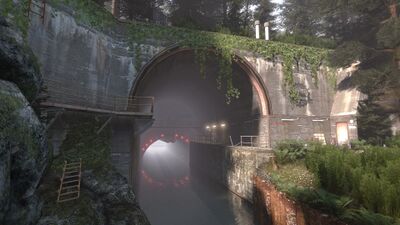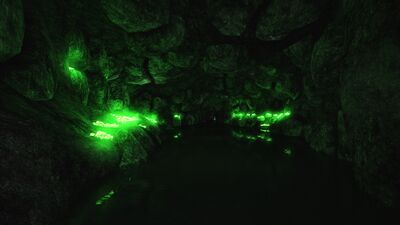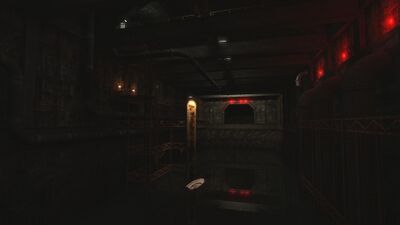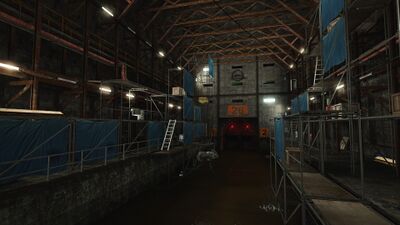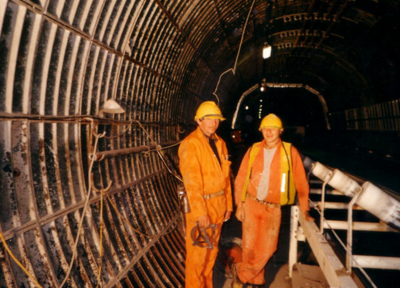Bergmann Water Tunnels: Difference between revisions
m (Let's stick to decimal comma for consistency, mmkey?) |
|||
| (3 intermediate revisions by 2 users not shown) | |||
| Line 5: | Line 5: | ||
Following the tunnel's collapse, the City of Stalburg awarded the contract for rebuilding the tunnels to the National Consulting Group. Reconstruction is still ongoing. | Following the tunnel's collapse, the City of Stalburg awarded the contract for rebuilding the tunnels to the National Consulting Group. Reconstruction is still ongoing. | ||
In ''INFRA'', the Bergmann Tunnels are featured in [[Tunnel1]], [[Tunnel3]], [[Tunnel4]], and [[ | In ''INFRA'', the Bergmann Tunnels are featured in [[Tunnel1]], [[Tunnel3]], [[Tunnel4]], [[Hallway]], [[Metroride]] and lastly in [[Waterplant]] | ||
==History== | ==History== | ||
| Line 20: | Line 20: | ||
{| class="sectionDivision" | {| class="sectionDivision" | ||
| | | | ||
''See also: [[Tunnel1]], [[Hallway]], [[Tunnel3]], [[Tunnel4]], [[Metroride]] and [[Waterplant]]'' | |||
[[File:Freshwater Tunnel 1 Start.jpg|right|400px|thumb|''The start of the tunnel no.1 in the Hammery Valley'']] | [[File:Freshwater Tunnel 1 Start.jpg|right|400px|thumb|''The start of the tunnel no.1 in the Hammery Valley'']] | ||
The first and the most important tunnel in the network, providing over 90% of the fresh water to the city, that among the citizens of Stalburg is commonly known as the "Bergmann Water Tunnel", the tunnel connects the Hammer Valley river to the [[Stalburg Central Water Plant]], moving water to the main reservoir. The tunnel hosts two major facilities lenghtwise, a [[Tunnel4|hydroelectric power plant]] built and operated in the past by [[Hammer Valley Hydro]] and a [[Tunnel2|Pine Fell Water Plant]] operated by [[Stalburg Water]], whose underground section controls the water flow rate in the tunnel, another minor water flow control facility is located between the major two. Throughout the tunnel at least 4 [[Main-Six|Water Flow Monitors]] are installed that radio communicate the state of the flow to the main control board at the [[Watertreatment|Pitheath Water Treatment Plant]] office. | The first and the most important tunnel in the network, providing over 90% of the fresh water to the city, that among the citizens of Stalburg is commonly known as the "Bergmann Water Tunnel", the tunnel connects the Hammer Valley river to the [[Stalburg Central Water Plant]], moving water to the main reservoir. The tunnel hosts two major facilities lenghtwise, a [[Tunnel4|hydroelectric power plant]] built and operated in the past by [[Hammer Valley Hydro]] and a [[Tunnel2|Pine Fell Water Plant]] operated by [[Stalburg Water]], whose underground section controls the water flow rate in the tunnel, another minor water flow control facility is located between the major two. Throughout the tunnel at least 4 [[Main-Six|Water Flow Monitors]] are installed that radio communicate the state of the flow to the main control board at the [[Watertreatment|Pitheath Water Treatment Plant]] office. | ||
| Line 26: | Line 28: | ||
The freshwater tunnel has built around it adjacent maintenance tunnels that allow workers to access various parts of the tunnel, including tunnel B3/C3 and [[Hallway|tunnel B2]] that are around 9 km long each and connect the two major facilities together, the latter spawned [[Mörkö|various myths]] around it and aroused fear among workers, advising not to use it. | The freshwater tunnel has built around it adjacent maintenance tunnels that allow workers to access various parts of the tunnel, including tunnel B3/C3 and [[Hallway|tunnel B2]] that are around 9 km long each and connect the two major facilities together, the latter spawned [[Mörkö|various myths]] around it and aroused fear among workers, advising not to use it. | ||
The tunnel is around 14,5 km long and parts of it were bored through underground caves, in which during the initial construction a species of [[Stalburg Mushroom Virus#Green Mushrooms|green glowing mushrooms]] was discovered, which thanks to the water reach of the tunnel, had spread to other parts of [[Stalburg]]. The tunnel was conceived in the first half of the 20th century after the second world war, as a response to a lack of potable water in the city due to pollution, and was constructed in under a decade, being the biggest tunneling project in the city to that date. | The freshwater tunnel itself is around 14,5 km long and parts of it were bored through underground caves, in which during the initial construction a species of [[Stalburg Mushroom Virus#Green Mushrooms|green glowing mushrooms]] was discovered, which thanks to the water reach of the tunnel, had spread to other parts of [[Stalburg]]. The tunnel was conceived in the first half of the 20th century after the second world war, as a response to a lack of potable water in the city due to pollution, and was constructed in under a decade, being the biggest tunneling project in the city to that date. | ||
[[File:Freshwater Tunnel 1 End.jpg|right|400px|thumb|''The end of the tunnel no.1 at a water reservoir in central Stalburg'']] | [[File:Freshwater Tunnel 1 End.jpg|right|400px|thumb|''The end of the tunnel no.1 at a water reservoir in central Stalburg'']] | ||
After the bankruptcy of the Bergmann Group in mid-February of 1980, the only remaining worker maintaining the tunnel was [[Erik]], where he did work completely alone until another worker, [[Robin]], was also assigned to this tunnel. Erik remained in position until his retirement on December 17, 1997, Robin continued to maintain the tunnel until his departure in the 2010s, leaving the tunnel mostly unsupervised. After falling into disrepair this tunnel along with tunnel no.2 started being used illegally by smugglers to move various goods, such as moonshine, with a makeshift dock raft from upper Hammer Valley to [[Obenseuer (district)|Obenseuer]]. According to the last performed maintenance reports, the tunnel was in a very bad shape, which was speculated to be in an imminent danger of collapsing. On August 8, 2016, a routine inspection of the floodgate controls at the first water tunnel, performed by [[Markku Siltanen]], caused this section of the tunnel to collapse, blocking the flow of water, and starting a chain reaction of instability in the tunnel that caused multiple more collapses throughout its whole length. | After the bankruptcy of the Bergmann Group in mid-February of 1980, the only remaining worker maintaining the tunnel was [[Erik]], where he did work completely alone until another worker, [[Robin]], was also assigned to this tunnel. Erik remained in position until his retirement on December 17, 1997, Robin continued to maintain the tunnel until his departure in the 2010s, leaving the tunnel mostly unsupervised. After falling into disrepair this tunnel along with tunnel no.2 started being used illegally by smugglers to move various goods, such as moonshine, with a makeshift dock raft from upper Hammer Valley to [[Obenseuer (district)|Obenseuer]]. According to the last performed maintenance reports, the tunnel was in a very bad shape, which was speculated to be in an imminent danger of collapsing. On August 8, 2016, a routine inspection of the floodgate controls at the first water tunnel, performed by engineer [[Markku Siltanen]], caused this section of the tunnel to collapse, blocking the flow of water, and starting a chain reaction of instability in the tunnel that caused multiple more collapses throughout its whole length. Section of the tunnel proceeding the central water plant was additionally affected when a weakened structure collapsed under the weight and the vibrations caused by a [[Metroride|maintenance tram]] Markku Siltanen was traveling in, taking the whole vehicle down to that partally dry section of the tunnel. | ||
|- | |- | ||
| | | | ||
| Line 39: | Line 41: | ||
| | | | ||
==Freshwater Tunnel No.3== | ==Freshwater Tunnel No.3== | ||
''See also: [[Tunnel4]]'' | |||
[[File:Freshwater Tunnel 3.jpg|right|400px|thumb|''Partially constructed section of the tunnel no.3'']] | [[File:Freshwater Tunnel 3.jpg|right|400px|thumb|''Partially constructed section of the tunnel no.3'']] | ||
Third tunnel was considered in the 1970's and later approved for construction, the boring work on the tunnel began on May 26, 1979, under the management of [[Jeff Walter]], and the project was expected to be completed in 1983, after which the Bergmann Group was contract-obligated to provide maintenance for the next 25 years. The tunnel was meant to house multiple hydroelectric power plants, built by Hammer Valley Hydro, and would be 7,2 km long, running from Ilanka to the Freshwater Tunnel No.1, however due to bankruptcy of the Bergmann Group in mid-February of 1980, only a small portion of the tunnel was completed. | Third tunnel was considered in the 1970's and later approved for construction, the boring work on the tunnel began on May 26, 1979, under the management of [[Jeff Walter]], and the project was expected to be completed in 1983, after which the Bergmann Group was contract-obligated to provide maintenance for the next 25 years. The tunnel was meant to house multiple hydroelectric power plants, built by Hammer Valley Hydro, and would be 7,2 km long, running from Ilanka to the Freshwater Tunnel No.1, however due to bankruptcy of the Bergmann Group in mid-February of 1980, only a small portion of the tunnel was completed. | ||
| Line 46: | Line 50: | ||
Despite the bankruptcy of the main contractor, the city major at that time reassured that the tunnel work will continue, however the actual construction never resumed and most of the excavation and construction equipment was left on the site, where it remained unsecured for years. | Despite the bankruptcy of the main contractor, the city major at that time reassured that the tunnel work will continue, however the actual construction never resumed and most of the excavation and construction equipment was left on the site, where it remained unsecured for years. | ||
|- | |||
| | |||
==Obenseuer Freshwater Tunnels== | |||
''Main article: [[Bergmann Maintenance Tunnels]]'' | |||
Separate from the tunnel no.2, there is another set of two major freshwater tunnels constructed by Bergmann Group, one coming south-western from Malmforst facility and another one coming north from a open water canal, that merge together into one tunnel beneath central Obenseuer and lead east-southeastern to the Obenseuer Water Treatment facility. All tunnels together are at least 4,4 km long. | |||
The main tunnel has 6 additional smaller tunnels that bring in water from other sources, whose floodgates are controlled from within a control room. The maintenance tunnels around the water tunnels are connected to the basements of [[Tenement B|Tenement]] and [[Deekula Basement|Deekula]] buldings, including a Tunnel B2 that connects the control room with the water treatment facility. | |||
Not much is know about circumstance of construction of these tunnels, however they were ignored when a major renovation of Bergmann tunnels had started in 2016. These tunnels were initially maintained by Robin for an unknown period of time, before he was replaced by [[Mike]] somewhen prior to 2026. The tunnels were left unsupervised after Mike had contracted the [[Fungal Disease]] and was unable physically to perform the job anymore. | |||
A local company, [[Nordmark Water Services]], has illegaly hooked up a water pump to the tunnels to redistribute potable water around surface tenements and charge for the service. | |||
|- | |||
| | |||
==Sewage Outflow Tunnel== | |||
A major tunnel that connects Eastport Sewage Plant with the outflow to the Baltic sea and is around 3,7 km long, moving the treated sewage out. | |||
Not much is known about its designation, construction circumstances or whether it was constructed by Bergmann Group. | |||
|} | |} | ||
==Other Notable Locations== | ==Other Notable Locations== | ||
Latest revision as of 17:46, 16 June 2024
The Bergmann Water Tunnels are a series of subterranean tunnels that carry raw water from the Hammer Valley and Two Gorges Valley to the Stalburg Central Water Plant, where the water is treated and distributed around Stalburg. The tunnels also provide water to the Pine Fell Water Plant, and contains a hydroelectric plant that generates electricity from the water flowing through the tunnels. In 2016, the tunnels are owned by the Stalburg City Council, with inspection and maintenance responsibilities contracted out to the National Consulting Group.
During a routine inspection on the 8th of August 2016, a floodgate failed and caused a tunnel to collapse a few hundred metres from the tunnel mouth in the Hammer Valley. This initial collapse triggered a series of other collapses along the tunnel, stopping all water flow across the entire network. The inability for water to flow from Lake Stalburg through the Hammer Valley was a major cause of the collapse of the Two Gorges Dam, which occurred 12 hours after the initial collapse.
Following the tunnel's collapse, the City of Stalburg awarded the contract for rebuilding the tunnels to the National Consulting Group. Reconstruction is still ongoing.
In INFRA, the Bergmann Tunnels are featured in Tunnel1, Tunnel3, Tunnel4, Hallway, Metroride and lastly in Waterplant
History[edit | edit source]
The Bergmann tunnels were a series of tunnels constructed by the Bergmann Group prior to war, with the Bergmann Water Tunnels being one of them. Some time after the completion of the tunnels, the Bergmann Group began a project to reroute the Bergmann tunnels. The project encountered multiple issues along the way, one of which was numerous collapses caused by instability in the tunnel construction area. After the Bergmann Group was dissolved, the construction project was cancelled, and maintenance of the tunnels was relinquished to the city. Since then, the tunnels have fallen into a state of disrepair, mostly caused by negligence. While navigating through the tunnels, Mark experiences numerous collapses, one of which ends up stopping the tunnel's water flow entirely.
Overview[edit | edit source]
The Bergmann Water tunnels consist mainly of large concrete pipes, most of which have no external access. However, certain sections of the tunnels are significantly enlarged to allow for the placement of various control centers and access points, mainly around the tunnel's flow control gates. These sections are connected by various access tunnels, including the infamous Tunnel B2. Connected to the tunnels are various maintenance-related areas, some of which have either collapsed or been sealed off after being allowed to fall into disrepair. Significant locations or equipment in the tunnels are identified either by numbers or a combination of letters and numbers (such as flood doors, valves, tunnels, etc.).
Certain sections of the tunnels appear to have been left unfinished (either accidentally or intentionally), and involve the water in the tunnel passing through various cave areas. These sections are particularly notorious for being a prime location for Green Shrooms to grow, and serve as Stalburg's main source of drinking water contamination.
Freshwater Tunnel No.1[edit | edit source]
|
See also: Tunnel1, Hallway, Tunnel3, Tunnel4, Metroride and Waterplant The first and the most important tunnel in the network, providing over 90% of the fresh water to the city, that among the citizens of Stalburg is commonly known as the "Bergmann Water Tunnel", the tunnel connects the Hammer Valley river to the Stalburg Central Water Plant, moving water to the main reservoir. The tunnel hosts two major facilities lenghtwise, a hydroelectric power plant built and operated in the past by Hammer Valley Hydro and a Pine Fell Water Plant operated by Stalburg Water, whose underground section controls the water flow rate in the tunnel, another minor water flow control facility is located between the major two. Throughout the tunnel at least 4 Water Flow Monitors are installed that radio communicate the state of the flow to the main control board at the Pitheath Water Treatment Plant office. The freshwater tunnel has built around it adjacent maintenance tunnels that allow workers to access various parts of the tunnel, including tunnel B3/C3 and tunnel B2 that are around 9 km long each and connect the two major facilities together, the latter spawned various myths around it and aroused fear among workers, advising not to use it. The freshwater tunnel itself is around 14,5 km long and parts of it were bored through underground caves, in which during the initial construction a species of green glowing mushrooms was discovered, which thanks to the water reach of the tunnel, had spread to other parts of Stalburg. The tunnel was conceived in the first half of the 20th century after the second world war, as a response to a lack of potable water in the city due to pollution, and was constructed in under a decade, being the biggest tunneling project in the city to that date. After the bankruptcy of the Bergmann Group in mid-February of 1980, the only remaining worker maintaining the tunnel was Erik, where he did work completely alone until another worker, Robin, was also assigned to this tunnel. Erik remained in position until his retirement on December 17, 1997, Robin continued to maintain the tunnel until his departure in the 2010s, leaving the tunnel mostly unsupervised. After falling into disrepair this tunnel along with tunnel no.2 started being used illegally by smugglers to move various goods, such as moonshine, with a makeshift dock raft from upper Hammer Valley to Obenseuer. According to the last performed maintenance reports, the tunnel was in a very bad shape, which was speculated to be in an imminent danger of collapsing. On August 8, 2016, a routine inspection of the floodgate controls at the first water tunnel, performed by engineer Markku Siltanen, caused this section of the tunnel to collapse, blocking the flow of water, and starting a chain reaction of instability in the tunnel that caused multiple more collapses throughout its whole length. Section of the tunnel proceeding the central water plant was additionally affected when a weakened structure collapsed under the weight and the vibrations caused by a maintenance tram Markku Siltanen was traveling in, taking the whole vehicle down to that partally dry section of the tunnel. |
Freshwater Tunnel No.2[edit | edit source]Second tunnel connects Obenseuer's open water canals, that branch off from the Fisch River, with the Freshwater Tunnel No.1 and is around 4,9 km long. The tunnel acts as an auxililary supply of water to the tunnel no.1, however the open canals the water goes through has been contaminated with mining slag, from the past mining operations, and sewage, dumped into the canals directly by the district residents. The tunnel also provides water intake for various factories south of it, splitting into multiple smaller tunnels, and has at least one major facility lengthwise. Not much is know about construction circumstances of this tunnel, however it is possible that it was constructed during a 20 years gap between the construction of first and third freshwater tunnels, between around the late 1950s to the late 1970s. This second tunnel is a continuation of the supply route used illegally by smugglers to deliver goods from upper Hammer Valley, through the tunnel no.1, to the Obenseuer district. |
Freshwater Tunnel No.3[edit | edit source]See also: Tunnel4 Third tunnel was considered in the 1970's and later approved for construction, the boring work on the tunnel began on May 26, 1979, under the management of Jeff Walter, and the project was expected to be completed in 1983, after which the Bergmann Group was contract-obligated to provide maintenance for the next 25 years. The tunnel was meant to house multiple hydroelectric power plants, built by Hammer Valley Hydro, and would be 7,2 km long, running from Ilanka to the Freshwater Tunnel No.1, however due to bankruptcy of the Bergmann Group in mid-February of 1980, only a small portion of the tunnel was completed. The construction of the tunnel sparked several controversies, Greenwar has opposed the tunnel project since its conception, raising concerns about decrease in water level of the Lake Stalburg and the effect on the groundwater along the tunnel's path. The tunnel construction also raised some concerns among on-site management regarding the possibility of excavation work putting tunnel no.1 in danger of collapse. After the bankruptcy of the Bergmann Group, two workers shared insight into the poor working conditions, dangerous work site and rushed preparation work during the construction. Despite the bankruptcy of the main contractor, the city major at that time reassured that the tunnel work will continue, however the actual construction never resumed and most of the excavation and construction equipment was left on the site, where it remained unsecured for years. |
Obenseuer Freshwater Tunnels[edit | edit source]Main article: Bergmann Maintenance Tunnels Separate from the tunnel no.2, there is another set of two major freshwater tunnels constructed by Bergmann Group, one coming south-western from Malmforst facility and another one coming north from a open water canal, that merge together into one tunnel beneath central Obenseuer and lead east-southeastern to the Obenseuer Water Treatment facility. All tunnels together are at least 4,4 km long. The main tunnel has 6 additional smaller tunnels that bring in water from other sources, whose floodgates are controlled from within a control room. The maintenance tunnels around the water tunnels are connected to the basements of Tenement and Deekula buldings, including a Tunnel B2 that connects the control room with the water treatment facility. Not much is know about circumstance of construction of these tunnels, however they were ignored when a major renovation of Bergmann tunnels had started in 2016. These tunnels were initially maintained by Robin for an unknown period of time, before he was replaced by Mike somewhen prior to 2026. The tunnels were left unsupervised after Mike had contracted the Fungal Disease and was unable physically to perform the job anymore. A local company, Nordmark Water Services, has illegaly hooked up a water pump to the tunnels to redistribute potable water around surface tenements and charge for the service. |
Sewage Outflow Tunnel[edit | edit source]A major tunnel that connects Eastport Sewage Plant with the outflow to the Baltic sea and is around 3,7 km long, moving the treated sewage out. Not much is known about its designation, construction circumstances or whether it was constructed by Bergmann Group. |
Other Notable Locations[edit | edit source]
Control Gate 1
Control Gate 1 is one of the three control gates located throughout the tunnels. Located near the tunnel entrance, the gate is situated in one of the maintenance areas scattered throughout the tunnel. One of the two control gates is jammed shut, presumably after it was allowed to fall into disrepair, and upon Mark's attempts to open the gate, the gate fails and causes a section of the tunnels to collapse.
Hammer Valley Hydro Outpost
Presumably a satellite facility of Hammer Valley Hydro, the outpost uses the fresh water supplied by the tunnels to generate electricity. The facility has presumably been abandoned for a significant amount of time, as the facility itself and surrounding areas have fallen into severe disrepair. The facility contains four hydroelectric generators, one of which has apparently caused significant trouble during the plant's operation. A note found on one of the facility's offices mentioning the generator causing a small ceiling collapse when activated, leaving one of the workers injured.
Tunnel B2
Possibly one of the most mysterious sections of the Bergmann Water Tunnels, Tunnel B2 is a connecting hallway that serves to connect the maintenance areas surrounding Control Gate 1 to sections further along in the tunnels. The tunnel is kept under tight security, making entry very difficult. This is likely done to not only prevent people from entering the tunnel, but also to keep the tunnel's main occupant, Mörkö, from escaping. Workers have reported various strange noises coming from the tunnel, and those who are curious enough to have a look inside often regret doing so soon after. Mörkö's presence in the tunnel is usually considered an "urban legend" by those who have not ventured into the tunnel.
